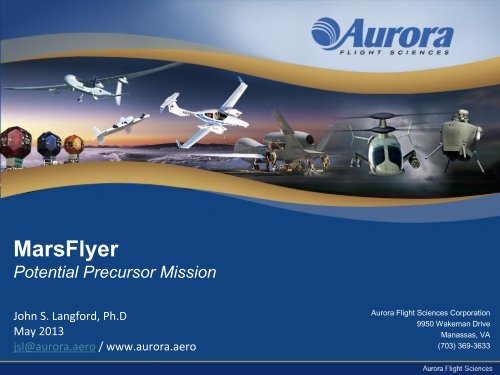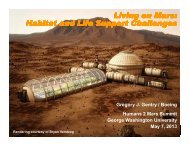Mars Precursor Missions_John Langford, MarsFlyer
Mars Precursor Missions_John Langford, MarsFlyer
Mars Precursor Missions_John Langford, MarsFlyer
- No tags were found...
You also want an ePaper? Increase the reach of your titles
YUMPU automatically turns print PDFs into web optimized ePapers that Google loves.
<strong>Mars</strong>FlyerPotential <strong>Precursor</strong> Mission<strong>John</strong> S. <strong>Langford</strong>, Ph.DMay 2013jsl@aurora.aero / www.aurora.aeroAurora Flight Sciences Corporation9950 Wakeman DriveManassas, VA(703) 369-3633AURORA PROPRIETARY
Why use airplanes for planetary research?• Airplanes will play the same role in planetary exploration thatthey have played in terrestrial exploration:• Surveillance & reconnaissance• Remote sensing• In situ sampling• Payload delivery• When temporal and spatial precision matter• Solar system bodies with potential for near-term dynamicflight:• <strong>Mars</strong>• Venus• Titan2
Unique <strong>Mars</strong> Airplane Design Challenges• Low Atmospheric Density• Low dynamic pressure requires low wing loading (aided by lower gravity)• Low flight Reynolds number degrades aerodynamic performance• Little freestream mass flow available for propulsion system cooling orgenerating thrust• Atmospheric Composition (mainly CO 2 )• Lack of O 2 leads to non-air-breathing propulsion• Lower speed of sound introduces compressibility effects at lower flight speeds• Transit to <strong>Mars</strong>• Launch and entry vehicles place strict geometric constraints on airplane• Additional thermal and acceleration loads not normally considered forairplanes• Transition from ballistic entry capsule to flying airplane is a critical design point3
Brief history of <strong>Mars</strong> airplane research• NASA-Dryden “Mini Sniffer”• Developmental Sciences• Aurora “Jason” concept at first DiscoveryWorkshop• NASA “<strong>Mars</strong> Airplane Project” (MAP)• NASA Langley “ARES” “<strong>Mars</strong> Scout I” Mission in2001• Successful deployment demonstration from 103,000’on September 19, 2002• Selected for Phase A in December 2002• Phoenix Lander ultimately selected• NASA Langley “ARES” proposed for <strong>Mars</strong> Scout II• MAVEN orbiter ultimately selected4
The <strong>Mars</strong> Airplane Project (1999)• NASA considered celebrating the 100thanniversary of the Wright Brother’s byflying an aircraft on another planet• A major competition was held in the Fallof 1999• Orbital, Aurora, Draper, and SAIC teamed• Lockheed/AeroVironment also bid• Langley was the lead NASA center• NASA canceled the project on November 5in order to free up funds for replacementto <strong>Mars</strong> Climate Orbiter• Before a winner was announced5
Unique Science that Complements andExtends the Core <strong>Mars</strong> Program Extends Viking, MGS, Odyssey, <strong>Mars</strong> Express and potential MRO discoveries Bridges the scale and resolution measurement gaps between orbitersand landers Survey of scientifically compelling terrain, inaccessible from the surface
ARES Mission OverviewTransfer Spacecraftto <strong>Mars</strong><strong>Mars</strong> InsertionInterplanetaryTrajectoryAircraft Releaseand DeploymentLaunch Sept/Oct ‘07Aboard Delta II 2925<strong>Mars</strong> Flight Nov 18,2008 90 minuteduration 750km range7
ARES – What Was ProposedComplementary science payload to address Near-SurfaceAtmospheric Chemistry and Crustal Magnetism themesVideo Camera Mass Spectrometer Magnetometer (2) Context Camera Point SpectrometerSingle large airplane outfittedwith heritage subsystemsDedicated communications assetvia a flyby spacecraft to providecontinuous data return during theairplane flight
ARES – The Science Mission
ARES Risk Area - Deployment and Pullout31 2
Successful Deployment and Pullout Performance in <strong>Mars</strong>Relevant ConditionsTail DeploymentLeft wing deploymentRight wing deploymentDeployments completex 10 43.253.23.15Altitude loss: 3% error3.1Altitude (m)3.0532.952.92.852.8-20 -10 0 10 20 30 40 50 60Time (s)11
A Uniquely Cross-Enterprise Endeavor• <strong>Mars</strong> Exploration• Atmospheric Chemistry, Crustal Magnetism, Mineralogy & Geology• The search for life• Aeronautical Technology• High Mach, low Reynolds number• Atmospheric entry, deployment, transition to winged flight• Earth Science• Regional-scale stratospheric measurements• Vertical profiles• Education & Public Outreach – STEM“One NASA” at its best12
Forward from Here• The first airplane to fly above another planet will be an event ofhistoric proportions• On par with Montgolfier, Wrights, Lindbergh, Vostok 1, Apollo 11• To date, perceived as too risky for the science missiondirectorate – and too much of a science mission by theaeronautics directorate• An affordable precursor mission that will capture the publicimagination and demonstrate vision and leadership13




